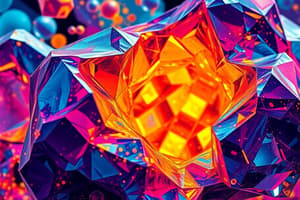Podcast
Questions and Answers
A vacancy is a point defect where an atom is added to the lattice site.
A vacancy is a point defect where an atom is added to the lattice site.
False (B)
It is possible to create a material that is completely free of vacancies.
It is possible to create a material that is completely free of vacancies.
False (B)
The equilibrium number of vacancies in a material decreases with increasing temperature.
The equilibrium number of vacancies in a material decreases with increasing temperature.
False (B)
A self-interstitial occurs when an atom is missing from the crystal lattice.
A self-interstitial occurs when an atom is missing from the crystal lattice.
For a solid solution to form, the crystal structure must change when solute atoms are added to the host material.
For a solid solution to form, the crystal structure must change when solute atoms are added to the host material.
Dislocations can only be one-dimensional defects in a crystal lattice.
Dislocations can only be one-dimensional defects in a crystal lattice.
Edge dislocation involves an extra portion of a plane of atoms that terminates outside the crystal.
Edge dislocation involves an extra portion of a plane of atoms that terminates outside the crystal.
The Burgers vector for an edge dislocation is perpendicular to the lattice distortion.
The Burgers vector for an edge dislocation is perpendicular to the lattice distortion.
Most dislocations in crystalline materials are either pure edge or pure screw dislocations.
Most dislocations in crystalline materials are either pure edge or pure screw dislocations.
Dislocations under a microscope are observed as bright lines due to their nature.
Dislocations under a microscope are observed as bright lines due to their nature.
Flashcards are hidden until you start studying




